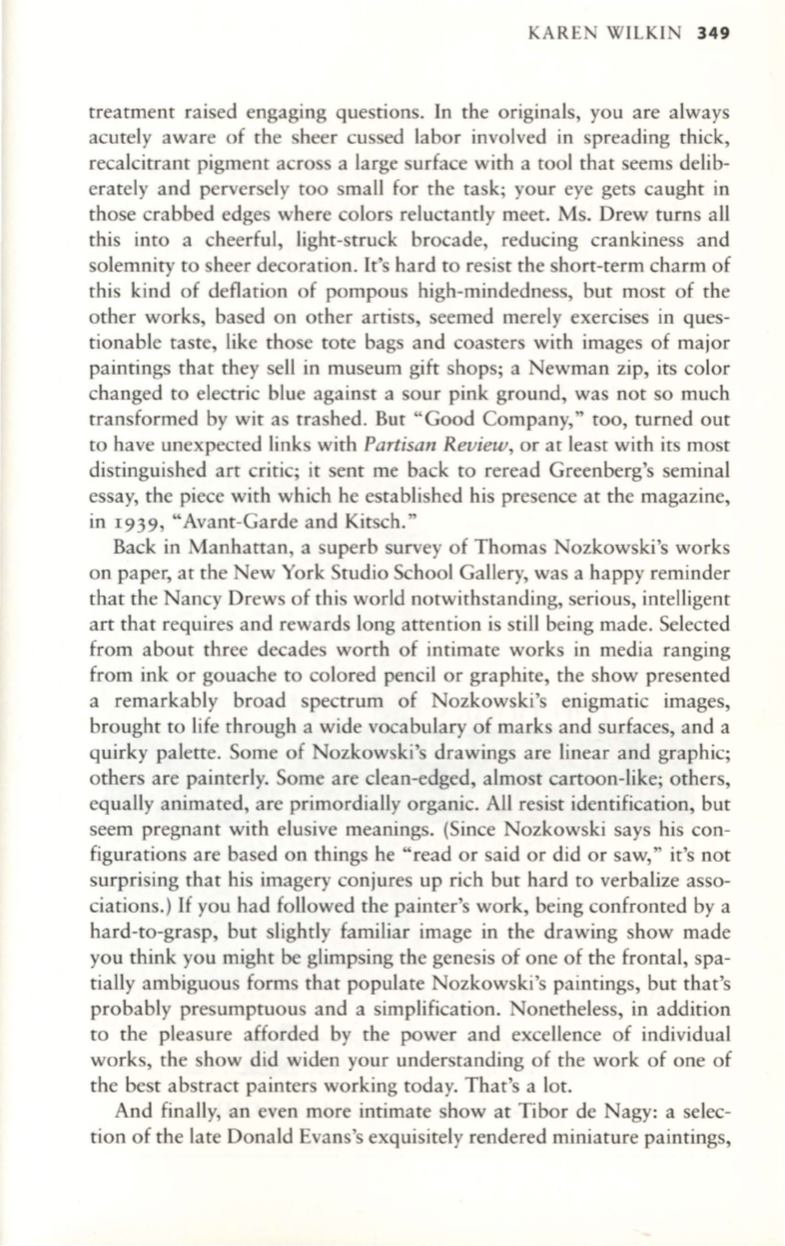
KAREN WILKIN
349
treatment raised engaging questions. In the originals, you are always
acutely aware of the sheer cussed labor involved in spreading thick,
recalcitrant pigment across a large surface with a tool that seems delib–
erately and perversely too small for the task; your eye gets caught in
those crabbed edges where colors reluctantly meet. Ms. Drew turns all
this into a cheerful, light-struck brocade, reducing crankiness and
solemnity to sheer decoration. It's hard to resist the short-term charm of
this kind of deflation of pompous high-mindedness, but most of the
other works, based on other artists, seemed merely exercises in ques–
tionable taste, like those tote bags and coasters with images of major
paintings that they sell in museum gift shops; a Newman zip, its color
changed to electric blue against a sour pink ground, was not so much
transformed by wit as trashed. But "Good Company," too, turned out
to have unexpected links with
Partisan Review,
or at least with its most
distinguished art critic; it sent me back to reread Greenberg'S seminal
essay, the piece with which he established his presence at the magazine,
in
1939,
"Avant-Garde and Kitsch."
Back in Manhattan, a superb survey of Thomas Nozkowski's works
on paper, at the New York Studio School Gallery, was a happy reminder
that the Nancy Drews of this world notwithstanding, serious, intelligent
art that requires and rewards long attention is still being made. Selected
from about three decades worth of intimate works in media ranging
from ink or gouache to colored pencil or graphite, the show presented
a remarkably broad spectrum of Nozkowski's enigmatic images,
brought to life through a wide vocabulary of marks and surfaces, and a
quirky palette. Some of Nozkowski's drawings are linear and graphic;
others are painterly. Some are clean-edged, almost cartoon-like; others,
equally animated, are primordially organic. All resist identification, but
seem pregnant with elusive meanings. (Since Nozkowski says his con–
figurations are based on things he "read or said or did or saw," it's not
surprising that his imagery conjures up rich but hard to verbalize asso–
ciations.)
If
you had followed the painter's work, being confronted by a
hard-to-grasp, but slightly familiar image in the drawing show made
you think you might be glimpsing the genesis of one of the frontal, spa–
tially ambiguous forms that populate Nozkowski's paintings, but that's
probably presumptuous and a simplification. Nonetheless, in addition
to the pleasure afforded by the power and excellence of individual
works, the show did widen your understanding of the work of one of
the best abstract painters working today. That's a lot.
And finally, an even more intimate show at Tibor de Nagy: a selec–
tion of the late Donald Evans's exquisitely rendered miniature paintings,


